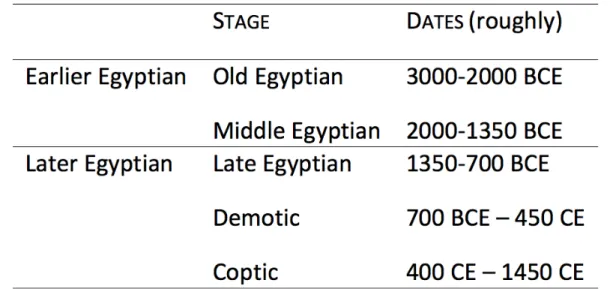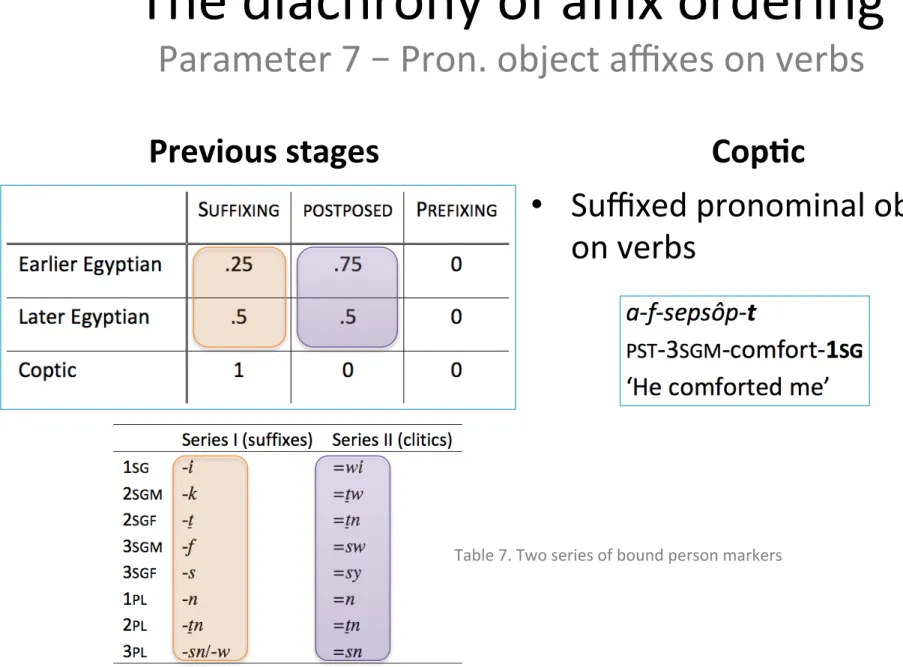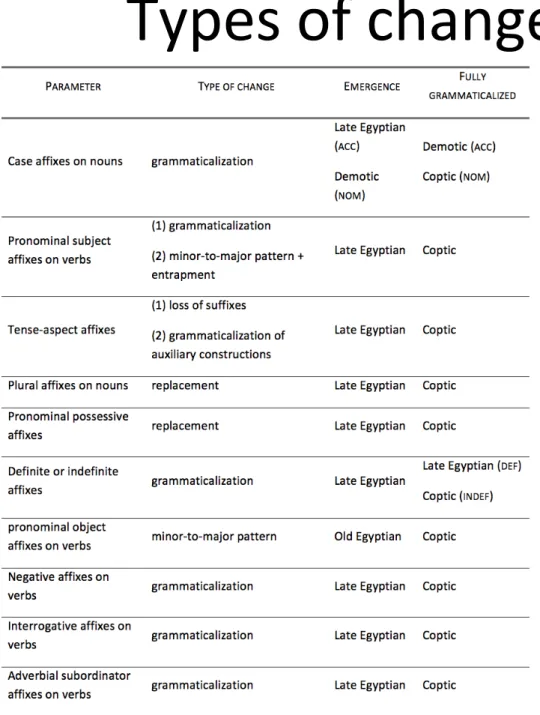Universally dispreferred
structures through change
The diachrony of affix ordering
in Egyp9an-Cop9c
Why are cross-linguisFcally rare features rare?
frequency asymmetries
•
Constraints on produc9on?
•
Constraints on percep9on/processing?
•
Constraints on learnability?
•
GeneFcally-determined Chomsky-style Universal Grammar?
•
Constraints on social interac9on?
‘... unusual or rare features are unusual or rare because they are the
accidental result of many different circumstances or condi9ons being lined
up in just the right way. […] If a construcFon can only develop by passing
through a relaFvely large number of changes, or can only develop if certain
condiFons exist, or some combinaFon of these, simple probability tells us
that it will be less common than a construcFon that develops through fewer
steps or requiring fewer condiFons. This explanaFon does not depend on one
change being less common than another, or on some condiFons being
infrequent;
E. Grossman (HUJi) & St. Polis (F.R.S.-FNRS) 4Some diachronic sources of rarity
1.
TYPE: the type of change is rare (vs. common types of change)
2.
PATH: few pathways to a parFcular situaFon (vs. mulFple pathways of change
that converge)
3.
STAGE: many-step or complex pathways of development (vs. one-step or simple
pathways)
4.
SOURCE: rare source construcFons vs. common source construcFons
5.
STABILITY: once grammaFcalized, the category type tends to be instable (vs
stable)
6.
DIFFUSABILITY: a certain property is not prone to diffusing through contact
Grossman (2016)
•
Introduc9on
Observa9on. A worldwide preference for suffixes as opposed to affixes
Argument. Rare or universally dispreferred structures can and do arise as the
result of regular language change, given the right background structures as the
parFcular ‘ecology’ in which change takes place
•
Case-study: Egyp9an-Cop9c (Afroasia9c)
Long-term diachronic macro-change from mixed suffixing-prefixing to an
overwhelming preference for prefixing
•
Conclusions
–
Each of the micro-changes implicated in this macro-change are bejer
understood in terms of changes at the level of individual construcFons, via
grammaFcalizaFon, rather than in terms of a broad Sapirian ‘drik.’
–
These micro-changes take place at different Fmes and have different rates
E. Grossman (HUJi) & St. Polis (F.R.S.-FNRS) 6A WORLDWIDE PREFERENCE FOR
SUFFIXES AS OPPOSED TO PREFIXES
•
There is a worldwide preference for suffixes as opposed to prefixes in a
proporFon of about 3 to 1 in the languages of the world (Bybee et al.
1990, Cysouw 2009, Greenberg 1957, Hall 1998, Hawkins & Cutler 1988,
Himmelmann 2014, Sapir 1921, and more)
Preference for suffixes
•
There is a worldwide preference for suffixes as opposed to prefixes in a
proporFon of about 3 to 1 in the languages of the world (Bybee et al.
1990, Cysouw 2009, Greenberg 1957, Hall 1998, Hawkins & Cutler 1988,
Himmelmann 2014, Sapir 1921, and more)
•
Two disFnct universal preferences (Himmelmann 2014): grammaFcal
morphemes have a significant tendency
(a) to be postposed and
(b) to be bound, i.e., suffixes
Some possible explanaFons:
–
a correlaFon with the linear order of major consFtuents (Jacques 2013)
–
some form of Universal Grammar
–
language contact (but see Seifart 2015)
–
processing or some other cogniFve mechanism (Cutler, Hawkins & Gillingan
1986, Caballero et al. 2008)
–
a world-wide retenFon from Proto-World (cf. Gell-Mann & Ruhlen 2011)
–
processes of language change, e.g., grammaFcalizaFon (Givón 1971, Bybee
1985, Bybee et. al 1990), perhaps due to online usage factors (Hall 1988,
Himmelmann 2014)
E. Grossman (HUJi) & St. Polis (F.R.S.-FNRS) 10Preference for suffixes
However:
•
‘it does not seem to be a fruiqul approach to consider the suffixaFon
preference as a monolithic observaFon to be explained by one
However:
•
‘it does not seem to be a fruiqul approach to consider the suffixaFon
preference as a monolithic observaFon to be explained by one
overarching theory of linguisFc affixaFon’ (Cysouw 2003: chap. 3)
•
Macro-characterisFcs of individual languages (e.g., Nichols 1986,
Haspelmath et al. 2014) result from generalizaFons made over individual
construcFons
E. Grossman (HUJi) & St. Polis (F.R.S.-FNRS) 12Preference for suffixes
•
This is captured by Dryer’s (2013) method for comparing the degree to
which languages are characterized by a preference for prefixing, suffixing,
or neither. He uses 10 parameters:
•
In Dryer (2013), a language receives:
–
a single point for prefixing or suffixing if it is predominantly prefixing or
suffixing for a given parameter,
–
half a point for each if it has both prefixing and suffixing, with neither deemed
dominant
–
no point when there is no affixing for a given parameter
•
The first three parameters (case affixes on nouns, subject and tense-aspect affixes in verbs) are deemed especially important: their score is
doubled
E. Grossman (HUJi) & St. Polis (F.R.S.-FNRS) 14Preference for suffixes
Table 3. Suffixing vs Prefixing in InflecFonal Morphology (Dryer 2003)
E. Grossman (HUJi) & St. Polis (F.R.S.-FNRS) 16
Table 3. Suffixing vs Prefixing in InflecFonal Morphology (Dryer 2003)
ANCIENT EGYPTIAN-COPTIC
•
Background informaFon
–
An independent branch of the AfroasiaFc phylum
–
First ajested at the end of the fourth millenium BCE, and documented
conFnually unFl someFme in the 13
thor 14
thcentury CE, when all of its
speakers shiked to Arabic
Ancient EgypFan-CopFc
•
Background informaFon
–
Standardly divided into five stages and and two macro-phases
•
Background informaFon
–
Standardly divided into five stages and and two macro-phases
E. Grossman (HUJi) & St. Polis (F.R.S.-FNRS) 20
Ancient EgypFan-CopFc
•
Background informaFon
22
Ancient EgypFan-CopFc
24
Ancient EgypFan-CopFc
•
Background informaFon
•
CopFc is a predominantly prefixing language
–
With its extremely high prefixing preference (12/13), CopFc belongs to the
rare 6% or so of languages that are predominantly prefixing.
–
Moreover, it has a higher prefixing index than any other language in Dryer’s
969-language sample. (The closest compeFtor is Hunde [Bantu; DemocraFc
Republic of Congo; Kahombo 1992], with a prefixing index of 9.5/13.)
•
Background informaFon
•
CopFc is a predominantly prefixing language
–
With its extremely high prefixing preference (12/13), CopFc belongs to the
rare 6% or so of languages that are predominantly prefixing.
–
Moreover, it has a higher prefixing index than any other language in Dryer’s
969-language sample. (The closest compeFtor is Hunde [Bantu; DemocraFc
Republic of Congo; Kahombo 1992], with a prefixing index of 9.5/13.)
E. Grossman (HUJi) & St. Polis (F.R.S.-FNRS) 26•
CopFc is an areal outlier
–
While predominantly
prefixing languages are
relaFvely common in
Mesoamerica and in Africa,
within Africa it is only in
western and southern sub-Saharan Africa that
predominant prefixing is
common
Methodology
•
We propose that for diachronic purposes, a modified form of Dryer’s typology is
useful
•
Rather than limiFng the score to 0 for no affix, 1 for either suffixing or prefixing,
and 0.5 for both prefixing and affixing, we suggest using two scales, which together
admit a more fine-grained analysis
28
Cop9c
•
Prefixed case markers (on
postverbal noun phrases in
S or A role)
Previous stages
Cop9c
•
Prefixed case markers (on
postverbal noun phrases in
S/A or P role)
Previous stages
Cop9c
•
Prefixed case markers (on
postverbal noun phrases in
S or A role)
Cop9c
•
Subject prefixes on verbs
Previous stages
Cop9c
•
Subject prefixes on verbs
Previous stages
Cop9c
•
Subject prefixes on verbs
E. Grossman (HUJi) & St. Polis (F.R.S.-FNRS) 34Type of change: development of a new pronoun paradigm (which gradually becomes
a subject prefix) and the shi] of a minor usage pa^ern (a periphrasFc construcFon
involving an auxiliary) to a major pa^ern
Cop9c
•
Tense-aspect prefixes on
verbs
Previous stages
Cop9c
•
Tense-aspect prefixes on
verbs
Previous stages
Cop9c
•
Tense-aspect prefixes on
verbs
Parameter 3
– Tense-aspect affixes on verbs
Type of change: Old tense-aspect suffixes are lost, while new TAM markers are
grammaFcalized from auxiliary verbs in periphrasFc construcFons. Since the linear
Cop9c
•
ProducFve: prefixed plural
markers
•
Non-producFve: plural-suffixing construcFon
(which oken involves stem-internal alternaFons)
E. Grossman (HUJi) & St. Polis (F.R.S.-FNRS) 38Previous stages
Cop9c
•
ProducFve: prefixed plural
markers
•
Non-producFve: plural-suffixing construcFon
(which oken involves stem-internal alternaFons)
Previous stages
Cop9c
•
ProducFve: prefixed plural
markers
•
Non-producFve: plural-suffixing construcFon
(which oken involves stem-internal alternaFons)
E. Grossman (HUJi) & St. Polis (F.R.S.-FNRS) 40Type of change: emergence of new
preposed determiners that
unambiguously mark number, and loss
of plural suffixes.
Cop9c
•
Possessor prefixes
•
Non-producFve: suffixed
possessives
Previous stages
Cop9c
•
Possessor prefixes
•
Non-producFve: suffixed
possessives
Previous stages
Cop9c
•
Possessor prefixes
•
Non-producFve: suffixed
possessives
Parameter 5
–
Pron. possessive affixes on nouns
Type of change: emergence of new
possessive determiners that start out
Cop9c
•
Definite and indefinite
prefixes on nouns
Previous stages
Cop9c
•
Definite and indefinite
prefixes on nouns
Previous stages
Cop9c
•
Definite and indefinite
prefixes on nouns
E. Grossman (HUJi) & St. Polis (F.R.S.-FNRS) 46Type of change: Gramma9caliza9on
(demonstraFve > definite arFcle > definite
affix; ‘one’ > indefinite arFcle > indefinite
affix) ; Independent word > affix
Cop9c
•
Suffixed pronominal object
on verbs
Previous stages
Cop9c
•
Suffixed pronominal object
on verbs
E. Grossman (HUJi) & St. Polis (F.R.S.-FNRS) 48
Previous stages
Cop9c
•
Suffixed pronominal object
on verbs
Parameter 7
–
Pron. object affixes on verbs
Type of change: shi] from a minor usage pa^ern to a major one. The ‘suffix takeover’ is
the result of grammaFcalizaFon of verb forms with suffixed P markers, and the loss of
verb forms with cliFc P markers, there is no ‘cliFc-to-affix’ grammaFcalizaFon involved
Cop9c
E. Grossman (HUJi) & St. Polis (F.R.S.-FNRS) 50
•
Portmanteau prefixes that
code both TAM values and
polarity
Previous stages
Cop9c
Parameter 8
–
NegaFve affixes on verbs
•
Portmanteau prefixes that
code both TAM values and
polarity
Previous stages
Cop9c
E. Grossman (HUJi) & St. Polis (F.R.S.-FNRS) 52•
Portmanteau prefixes that
code both TAM values and
polarity
Type of change: from Late EgypFan onwards, negaFons in main verbal clauses began to
be univerbated with TAM auxiliaries (univerba9on, gramma9caliza9on of portmanteau
TAM/Polarity prefixes)
Cop9c
•
Unmarked yes/no quesFons
•
With interrogaFve prefixes
Cop9c
•
Unmarked yes/no quesFons
•
With interrogaFve prefixes
E. Grossman (HUJi) & St. Polis (F.R.S.-FNRS) 54Previous stages
Type of change: secondary
grammaFcalizaFon from focus morphology
to interrogaFve morphology
Cop9c
•
CopFc has a set of verbal
prefixes that indicate
subordinate-clause status
Previous stages
Cop9c
•
CopFc has a set of verbal
prefixes that indicate
subordinate-clause status
Previous stages
Cop9c
•
CopFc has a set of verbal
prefixes that indicate
subordinate-clause status
Parameter 10
–
Adv. subordinator affixes on
verbs
Type of change: from Late EgypFan onwards, clause-iniFal conjuncFons begin to
be univerbated with auxiliary verbs, creaFng, in effect, adverbial subordinator
prefixes on verbs (gramma9caliza9on, via periphrasis and univerba9on)
UNIVERSALLY DISPREFERRED
STRUCTURE THROUGH CHANGE
Conclusions
Types of change and stages
Table 8. Summary of types of changes, period of emergence and of full grammaFcalizaFon
60
Types of change and stages
Table 8. Summary of types of changes, period of emergence and of full grammaFcalizaFon
GrammaFcalizaFon
Minor to major pajerns
62








